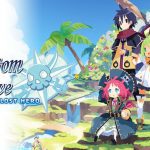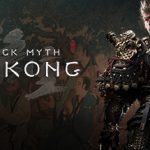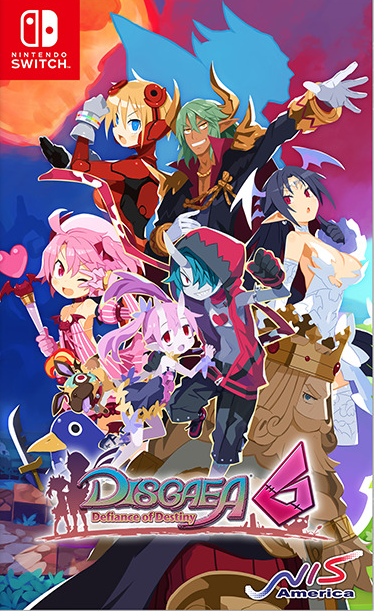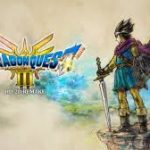I’ve been a Disgaea fan since the first one on PS2, and it was also my intro to Nippon Ichi Software as a whole. Been a fan of the company since, though they have been a bit disappointing of late with some of their titles (like The Princess Guide and Lapis X Labyrinth), or releasing merely “okay” level games (like Void Terrarium and Mad Rad Dead). And there’s a few of their recent games I missed like Poison Control (I want to check that one out but other games took priority). They have released some REALLY good stuff recently-ish though, such as Labyrinth of Refrain (and that’s got a sequel that will hopefully get localized… but it didn’t come out on Switch for some reason, so who knows if they’ll even bother).
Disgaea 6 marks a whole 6 years since the last entry in the series, with the series being in port-hell in-between (Disgaea getting a bunch of ports is normal, but usually there’d be main games a bit faster). The usual gap between Disgaea releases has been 2-3 years, so this was particularly long. So I was pretty hyped to finally get more Disgaea.
Well without further ado, let’s talk about the lastest game in the series!
Developer: Nippon Ichi Software
Publisher: NIS America
Release date: June 29th 2021
Platforms: Switch (also on PS4 in Japan but not in the west, probably because NIS wouldn’t want to censor Melodia)
Genre: Strategy RPG
So to start, I guess I need to talk about the elephant in the room as far as how a Disgaea review should go: no, I am not done with all the post-game content. Not even close. I got started on Carnage difficulty, but I am nowhere near done with that and I am nowhere near starting Rakshasa difficulty stuff. I’ve never been a Disgaea completionist, I just tend to enjoy the gameplay enough to get the story done and get started on the post-game grind, but I usually get into other games before I get that far into the post-game. So there’s probably some things I don’t know about the post-game, which is technically the main game as far as Disgaea goes, if you ask many of its fans. But it’s not the part I’m most interested in myself. If you want a full lowdown on that aspect of the game, I’ll touch into it mildly, but this isn’t it. So anyways, on with the actual review!
The most glaring change from the old games is the graphics. No more nice 2D sprites, now you have slightly-less-nice 3D models, which are pretty accurate interpretations of the 2D sprites from the old games, with less anti-aliasing. They’re not quite as nice, but they do the job. You get smoother animations generally, but I dunno, the sprites look a nicer overall. The tradeoff is that the animations for attacks can be more detailed compared to the limited 2D sprites. Sometimes you just can’t even tell the difference, so it makes me wonder why the change happened. The rest of the game visually is much as you’d expect. Fairly cube-like environments that you move your characters in, with pretty easy to tell grids so the movement is simple to see and do. This new 3D thing does have some issues though, at least for the Switch version (no idea for the PS4 version). Namely, the framerate drops, a lot, frequently. I’m not sure why. It doesn’t render the game unplayable, but it’s definitely noticeable. The character design is much as you’d expect of course, the series has all its archetypes in there. One of the more interesting ones to me was Misedor, because I assumed he’d just be this one-chapter character (I feel there’s been similar-looking kings in previous games), and suddenly he was in my team.
On the story side, it’s fine. You play as Zed, a zombie who is trying to defeat the God of Destruction. This particular God of Destruction is apparently the strongest one ever. Zed has the help of Cerberus, a zombie dog who claims to have previously been a super sage. Cerberus has Zed under the Super Reincarnation spell, so if the God of Destruction kills Zed, he comes back, but stronger and in a different universe. At the start of the game he’s gone through this thousands of times already. The game here focuses on Zed super reincarnating in different worlds where he meets people who will ally with him in his quest to defeat the God of Destruction. They each have their own weird personality problems to deal with, or their reasons to fight. Zed himself is fighting so hard for his sister, for example. Strangely enough, the character I ended up liking most in this game is Melodia. She was pretty annoying at first with her singing, but she has a lot of really fun character growth. So yeah, there’s all this mystery about the God of Destruction and stuff, there’s some good twists in there. The story itself is a bit weird actually, because it’s told by Zed to an Overlord AFTER he beat the God of Destruction. So you know the God gets defeated, but not how, or why they’re in the overlord’s castle. Maybe there’s a bit more to that after, huh? It’s not bad, though I think some of it is resolved pretty stupidly by the end. Also this story does have a pretty big problem when it comes to combat variety… I think every final battle in every chapter in the main campaign involves just fighting the God of Destruction (and some chapters have multiple fights against it). It gets a bit ridiculous.
So the core gameplay here is largely as you’d expect from Disgaea. Every mission starts you at the beginning of a level where you have a base panel. The game is in a square grid format, with one unit per square. When you select the base panel, you take one of your characters out of it, and which point you can give it orders. Units can move, attack, defend, lift something from an adjacent square, throw something that they’re lifting, use items, or use skills. Attacks are usually for 1 square away, though obviously some weapons hit from a bit further, like spears hitting 2 away, guns shooting like 5 or 6 away in a straight line and bows shooting 3 spaces away in a radius. Skills also have a variety of ranges. Some hit an area, some have a range where you then hit an area within that range, some hit a specific distance away, and so on. Getting attacked always has a chance of triggering a counter if the attacker is in range for you, and counters always have a chance of triggering more counters. A core of the movement here is lifting allies and throwing them a large distance so you can cover more ground, it’s a good way to get far into some levels that are just longer, or to set up for later turns. A fun thing here is that you don’t need to cancel movement anymore if you want to change your positioning, you can keep using the move command to move again (within the original range of movement from where you started the turn) which is pretty useful.
Game flow is pretty simple, just go to the dimension guide and choose the next mission. There’s I think 14 chapters with 5 battles each. But there’s a lot of in-between stuff, that I’ll get into later. Pretty much, if you want to keep it very straightforward and just progress through the story, you can do that with minimal grinding probably. I did grind some though. In-between battles you’re in a pocket dimension that has stores, a hospital and various NPCs that help for different things. You can change your equipment and skills and power up in different ways that I will talk a bit about later.
Disgaea has always not really been about the story and main campaign though. What it IS about is NUMBERS. And GRINDING. And RIDICULOUSLY POWERFUL POSTGAME BOSSES. And LEVEL 9999 CHARACTERS. This is all still here. There’s some differences though. One of the main ones is how experience works. You don’t get experience for killing enemies… sort of. You don’t get experience during a stage. Instead you get the experience after the stage, and it’s given to all the characters you had deployed on the map when the battle ended. Even if a character died. Even if a character literally didn’t move off the base panel. The EXP is still based on the enemies you kill (including the bonus EXP of killing them on +EXP geo panels), but you can actually level up a whole bunch of characters at once. If you want to focus the EXP on one character, there’s always the “Hog all the EXP” thing in the Dark Assembly that will take all the EXP gained by all the characters that were deployed and give it all to one character. There’s many ways to increase EXP, from putting a bunch of statisticians in your equipment (up to 900 levels of Statisticians, increasing the EXP gain by 1% each, so 900% max). And there’s the Cheat Shop, where you can increase enemy levels for more EXP and also take away stat gains for other points (money, class, mana and such) and put those into EXP gain (up to 1000% gain, though that also means sacrificing point gains in other areas so you might not want to go all-in with that all the time). There’s also evilities that provides extra EXP gain, and I’m sure there’s a couple other things that might.
You have many extra ways to power up your characters. Of course the simplest one is equipping them with better items. Items themselves can get powered up through Item World. In Item World you go through a long dungeon. Each floor is a simple, randomized map to fight enemies in, and certain actions here such as breaking level spheres, subduing innocents and doing special maps in Mystery Rooms will, once you get out of the world, power up your item. There’s a weird thing with Item World, if you level up an item that’s in the store, it makes any future item you buy powered up to that level (I think there’s some ways you can grind for money doing this). As a quick note on items, it’s not really worth leveling things up too much during the story, because the regular items suck balls compared to Carnage items, which suck balls compared to Raksasha items. Then there’s the Evility shop where you can spend Mana to make your skills better (but also make them cost more MP to use), as well as purchase evilities and various other things with evilities. Evilities are basically cool passive skills that power you up in different ways, but you have limited slots to place them in. A surprising thing as far as skills is that attacking normally tends to be better without massively powering up the skills. The Squad shop lets you put your characters in Squads! Pretty self-explanatory. Each squad has different effects, usually based on how many characters are in them, such as making the Juice Bar more effective, or powering up certain stats for all squad members, or giving members some percentage of the EXP the leader of the squad gets. And then there’s the Juice Bar. By getting extracts for different stats (there’s plenty of places to get these) and spending money for each stat you increase, you can drink stat-increasing juice. Fun.
And finally another big thing is the Super Reincarnation (outside of the story). Basically you get Karma in a few ways, the main one being spending 5000 mana when you reincarnate, you get Karma I think based on your level? I might be wrong. Each reincarnation gives you more stats based on the level you were when you reincarnated as well. You can use the Karma points you get extra stats, or some “skills” such as extra throw distance, movement and damage dealt. This is also where you do a few specific things like busting the level limit. More on that in a second. The other way to get Karma that I know of is the D-Merit system. Basically several actions in the game give you D-Merits, which are basically character-exclusive achievements. Leveling up, killing allies, spending money/extracts at the juice bar and several things not only give Karma, but also access to more Evilities, and increases to EXP earned and other stuff. You do need a LOT of Karma for some of these things like the level limit. I’m sure some people know exactly how to get enough of it for everything though. Also reincarnating non-unique characters let’s you make much stronger versions of them if they leveled up their class enough (or even switch class entirely I think). Like the Mecha Girl class, you can eventually get one of those up to the “War Lady” class, which, because of certain attack skills, is extremely useful in the post game.
Another new thing is that LEVEL 9999 isn’t… really meaningful anymore. Because now it’s LEVEL 99999999. At first it’s 9999, but after you finish the main campaign, you get the ability to unlock Carnage difficulty in the Dark Assembly (which I barely talked about… it’s not that important), which enables you to break the level limit from 9999 and make it 9999999. Eventually (I assume after you complete the Carnage missions) you unlock Rakshasa difficulty, and same thing happens there, you get to bust the limit a second time to 99999999. What this means is that stats get to absurd levels. A character could reliably get to several trillions of a stat if you grind enough, and HP/MP specifically can get to quintillions. Because you need that to deal with some of the tougher enemies. There’s totally methods to get to max level in a single battle, but there’s still some grinding and planning required to get to that point. Basically, after the main campaign is done, the game becomes a massive grind. And for some, that’s the entire appeal of Disgaea 6.
The game has a weird focus on auto-battles. Basically you can repeat a level automatically and have the game do the battle for you with AI. You can use this to repeat level grind stages, or to automatically do item worlds. There’s a system called Demonic Intelligence. Basically you can program your characters to act in certain ways, using a grid and different actions based on conditions. I haven’t experimented much with this, but essentially you can get the game to grind for you while you’re not actually playing. Not a huge fan of that, might as well just make the grinding quicker instead of putting a system for the game to grind for you.
Another issue to rightfully complain about is the really shitty DLC. This is stuff that would’ve just, you know, been in the game in a pre-DLC world. Here for a bit over 5$ (Canadian) you get one character, and a small set of battles to get that character. That’s fucking ridiculous for a strategy RPG. 5$ for a character in a fighting game is a bit much IMO (compared to the full roster of a fighting game, price-wise), but it’s more understandable because there’s… actual work done for how the character plays in a fighting game. Here, sure the characters might have evilities that are useful for grinding, but by the time they even come out you might be done with the game anyways. Pretty ridiculous. At least the hololive DLC is free (why is Flare’s character called Torte? All the others have names similar to their real hololive counterpart, like Watame’s character being called Watameh)… it’s nothing much but it’s nice.
There’s probably a few things to talk about, but I’ll leave that to my overall thoughts.
Overall
Disgaea 6… was fun. But it had issues.
I actually don’t mind the simplified EXP system, it lessens the grinding a bit since you can level lots of characters at once more easily. The story campaign is kinda ass because half the shit you fight is the literal same God of Destruction. Also there’s no more monster weapons which is an odd change, but the biggest change in this regard is class variety, both in enemies and what you can create for your party… for comparison, Disgaea 5 had, counting both humans and monsters, 44 character types you could create (not counting unique story characters, and DLC and other bonus characters). Disgaea 6 has 22, and the monster ones, due to using normal weapons, are basically just humanoid classes with a different look. Also chara world is gone I guess, as is curry. To compensate you’d think there’s be a bunch of new stuff, but there kinda isn’t. I think the Item World Research is new? Karma and D-Merits are new, and Karma sucks TBH, having just Mana would be better. The Juice Bar is new and is a great way to get stronger but you gotta grind that money and those extracts.
This game tries to impress with its big numbers, moreso than usual, but it’s just more grinding time. I guess it’s similar to the old grinding time though, considering leveling to 9999 isn’t really that complicated when a single battle can gain you 30000 levels with very little effort on your side (and that’s before finishing the main campaign, things get way faster than just 30000 levels in one battle once you unlock later ), and the max level (after passing certain conditions) is 99999999. Yeah it’s kinda funny that you can get stats in the trillions and HP in the quintillions and there’s a massive amount of min-maxing if you’re into that… but in the end it just feels like the same kinda stuff as the other games, just with numbers that are bigger. I thought it was pretty weird that I had several level 9999 super reincarnations by the time I finished the main story, when I never even get close to level 9999 in other games before the story is over. Just shows how different the whole grinding experience is in this one.
This game also has a weirdly large focus on auto-battles, where you can actually program your characters to act in certain ways and then just let them go and have them grind item worlds and grinding maps on their own without you having to even be around (yes passing triple EXP bills obviously shortens real-time, but if you’re not around and just let it go that hardly matters… though I hear there can be errors where auto-battles just stop).
There is stuff to love about Disgaea 6. It’s still Disgaea so it’s good based on that alone. The story is pretty decent. I like some of the characters. If you like big numbers and thinking out how to min-max your characters, this game definitely delivers, not many games gets to trillions after all. The music is great, though there’s a decent amount of recycling going on here. The grinding is still largely as interesting as usual, though again I do find the auto-battle thing… meh.
Overall, I recommend… any Disgaea game. Even if I have my own issues with 6, it’s still Disgaea so it’s still good.








Leave a reply